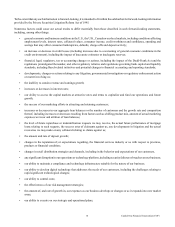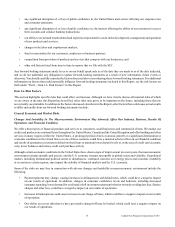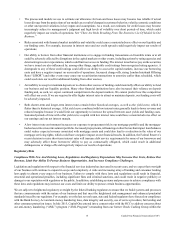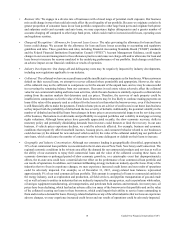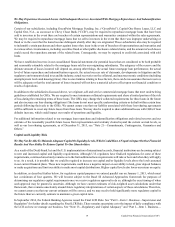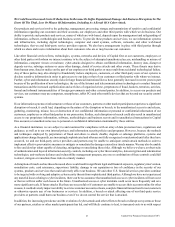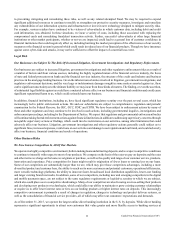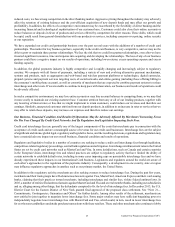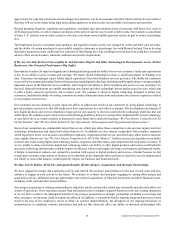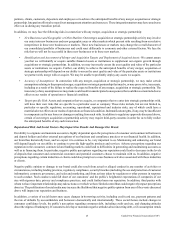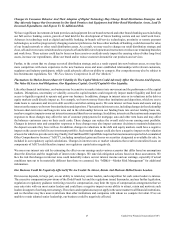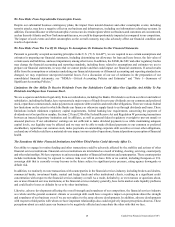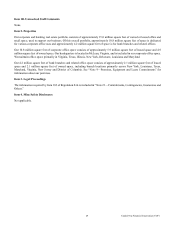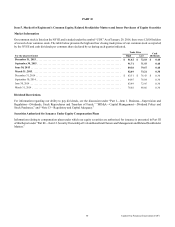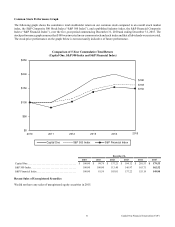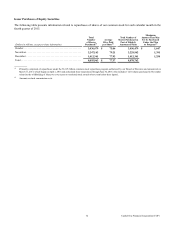Capital One 2015 Annual Report Download - page 43
Download and view the complete annual report
Please find page 43 of the 2015 Capital One annual report below. You can navigate through the pages in the report by either clicking on the pages listed below, or by using the keyword search tool below to find specific information within the annual report.24 Capital One Financial Corporation (COF)
aggressively for caps and restrictions on interchange fees and there can be no assurance that their efforts will not be successful or
that they will not in the future bring legal proceedings against us or other credit card and debit card issuers and networks.
Beyond pursuing litigation, legislation and regulation, merchants may also promote forms of payment with lower fees, such as
ACH-based payments, or seek to impose surcharges at the point of sale for use of credit or debit cards. For example, a consortium
of large U.S. retailers was recently created to develop a merchant-owned mobile payment system in part to reduce interchange
fees.
The heightened focus by merchants and regulatory and legislative bodies on the fees charged by credit and debit card networks,
and the ability of certain merchants to successfully negotiate discounts to interchange fees with MasterCard and Visa or develop
alternative payment systems could result in a reduction of interchange fees. Any resulting loss in income to us could have a material
adverse effect on our business, financial condition and results of operations.
If We Are Not Able To Invest Successfully In And Introduce Digital And Other Technological Developments Across All Our
Businesses, Our Financial Performance May Suffer.
Our industry is subject to rapid and significant technological changes and our ability to meet our customers’ needs and expectations
is key to our ability to grow revenue and earnings. We expect digital technologies to have a significant impact on banking over
time. Consumers increasingly expect robust digital experiences from their financial services providers. The ability for customers
to access their accounts and conduct financial transactions using digital technology, including mobile applications, is an increasingly
important aspect of the financial services industry and it impacts our ability to deliver products and services to our customers. To
that end, financial institutions are rapidly introducing new digital and other technology-driven products and services, which aim
to offer a better customer experience and to reduce costs. We continue to invest in digital technology designed to attract new
customers, facilitate the ability of existing customers to conduct financial transactions and enhance the customer experience related
to our products and services.
Our continued success depends, in part, upon our ability to address the needs of our customers by using digital technology to
provide products and services that efficiently meet their expectations in a cost-effective manner. The development and launch of
new digital products and services depends in large part on our capacity to invest in and build the technology platforms that can
enable them. We continue to actively invest in such technology platforms, however, we may fail to implement the correct technology,
or may fail to do so in a timely manner as discussed in more detail above under the headings “We Face Intense Competition In All
Of Our Markets” and “We Face Risks Related To Our Operational, Technological And Organizational Infrastructure.”
Some of our competitors are substantially larger than we are, which may allow those competitors to invest more money into their
technology infrastructure and digital innovation than we do. In addition, we face intense competition from smaller companies
which experience lower cost structures and different regulatory requirements than we do, and which may allow them to innovate
more rapidly than we can. See “We Face Intense Competition In All Of Our Markets.” Further, our success depends on our ability
to attract and retain strong digital and technology leaders, engineers and other talent, and competition for such talent is intense. If
we are unable to attract and retain digital and technology talent, our ability to offer digital products and services and build the
necessary technology infrastructure could be negatively affected, which could negatively impact our business and financial results.
A failure to maintain or enhance our competitive position with respect to digital products and services, whether because we fail
to anticipate customer expectations or because our technological developments fail to perform as desired or are not implemented
in a timely or successful manner, could negatively impact our business and financial results.
We May Fail To Realize All Of The Anticipated Benefits Of Our Mergers, Acquisitions And Strategic Partnerships.
We have engaged in merger and acquisition activity and entered into strategic partnerships over the past several years and may
continue to engage in such activity in the future. We continue to evaluate and anticipate engaging in, among other merger and
acquisition activity, additional strategic partnerships and selected acquisitions of financial institutions and other financial assets,
including credit card and other loan portfolios.
Any merger, acquisition or strategic partnership we undertake entails certain risks, which may materially and adversely affect our
results of operations. If we experience greater than anticipated costs to integrate acquired businesses into our existing operations
or are not able to achieve the anticipated benefits of any merger, acquisition or strategic partnership, including cost savings and
other synergies, our business could be negatively affected. In addition, it is possible that the ongoing integration processes could
result in the loss of key employees, errors or delays in systems implementation, the disruption of our ongoing businesses or
inconsistencies in standards, controls, procedures and policies that adversely affect our ability to maintain relationships with


